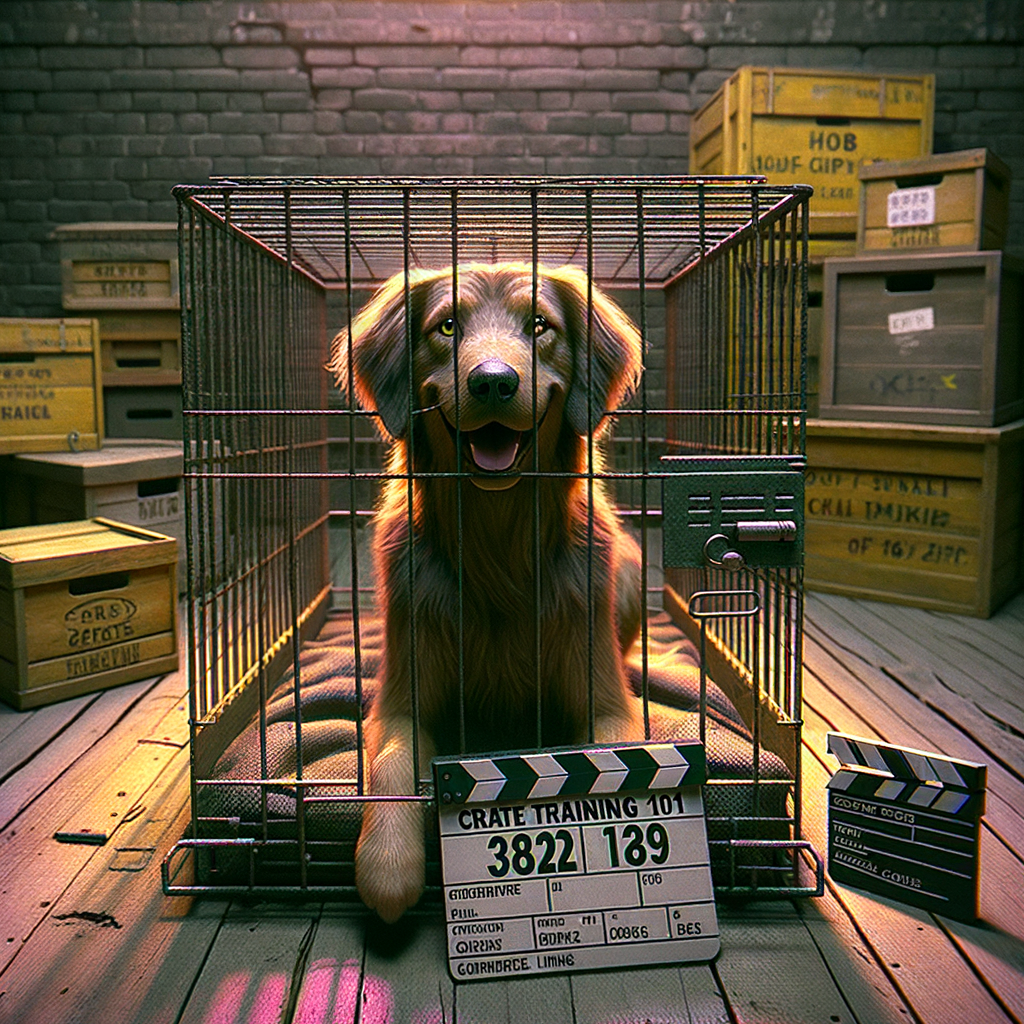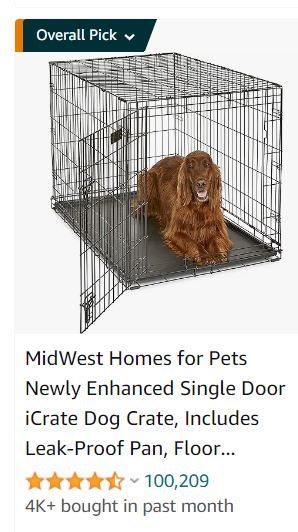Crate Training 101: Tips for a Happy and Secure Dog

Crate Training 101: Tips for a Happy and Secure Dog
-
Table of Contents
Introduction
Crate training is a popular method used to provide dogs with a safe and secure space of their own. It involves using a crate or kennel as a training tool to teach dogs to feel comfortable and relaxed in confined spaces. This article will provide you with essential tips and guidelines for successful crate training, ensuring a happy and secure environment for your furry friend.
Benefits of Crate Training for Dogs
Crate Training 101: Tips for a Happy and Secure Dog
Crate training is a popular method used by many dog owners to provide their furry friends with a safe and secure space. While some people may view it as confining or cruel, when done correctly, crate training can actually have numerous benefits for both the dog and the owner. In this article, we will explore the benefits of crate training for dogs and why it is worth considering for your own canine companion.
One of the primary benefits of crate training is that it helps with housebreaking. Dogs naturally have an instinct to keep their sleeping area clean, and by using a crate, you can take advantage of this instinct to teach them to hold their bladder and bowels. By confining them to a crate when you are unable to supervise them, you can prevent accidents in the house and establish a routine for potty breaks. This not only saves your carpets and furniture from potential damage but also helps your dog develop good bathroom habits.
Additionally, crate training can provide a sense of security and comfort for your dog. Dogs are den animals by nature, and a crate can serve as their own personal den. It becomes a safe and cozy space where they can retreat to when they feel anxious or overwhelmed. This is especially beneficial during times of stress, such as thunderstorms or fireworks, as the crate provides a familiar and secure environment that can help calm their nerves.
Furthermore, crate training can be a valuable tool for managing your dog’s behavior. When properly introduced and used, a crate can prevent destructive behaviors such as chewing on furniture or getting into things they shouldn’t. By confining them to their crate when you are unable to supervise them, you can ensure that they are not getting into trouble and keep them safe from potential hazards. This can also be helpful when introducing a new puppy to your home, as it allows you to gradually introduce them to different areas of the house and prevent them from getting overwhelmed.
In addition to these practical benefits, crate training can also have positive effects on your dog’s overall well-being. Dogs are social animals, but they also need their own space and time to relax. A crate provides them with a designated area where they can have some alone time and recharge. This can be especially important in multi-dog households, where each dog can have their own crate to retreat to when they need a break from their furry siblings.
It is important to note that crate training should always be done in a positive and gentle manner. The crate should never be used as a form of punishment, and your dog should never be forced into the crate. Instead, you should gradually introduce them to the crate, using treats and praise to create positive associations. Make the crate a comfortable and inviting space by adding a soft bed or blanket, and never leave your dog in the crate for extended periods of time.
In conclusion, crate training can provide numerous benefits for both dogs and their owners. From aiding in housebreaking to providing a secure and comforting space, a crate can be a valuable tool in raising a happy and well-behaved dog. Just remember to introduce the crate gradually and always use positive reinforcement. With patience and consistency, crate training can be a positive experience for both you and your furry friend.
Step-by-Step Guide to Crate Training Your Dog
Crate training can be a valuable tool for both you and your furry friend. It provides a safe and secure space for your dog, while also helping with house training and preventing destructive behavior. If you’re new to crate training, don’t worry! This step-by-step guide will walk you through the process and give you some helpful tips along the way.
First things first, choose the right crate for your dog. It should be large enough for your dog to stand up, turn around, and lie down comfortably. However, it shouldn’t be too big, as dogs are less likely to soil their sleeping area. Opt for a crate made of sturdy materials and with a secure latch to prevent any escape attempts.
Next, introduce your dog to the crate gradually. Start by placing the crate in a quiet area of your home and leave the door open. Allow your dog to explore the crate at their own pace, using treats and praise to create positive associations. You can also place a soft blanket or bed inside to make it more inviting.
Once your dog is comfortable entering and exiting the crate, it’s time to start closing the door. Begin by closing the door for short periods while you’re still in the room. Gradually increase the duration, always rewarding your dog for calm behavior. This will help them understand that being in the crate is a positive experience.
Now it’s time to start leaving your dog alone in the crate. Start with short absences, such as stepping outside for a few minutes. Gradually increase the time you’re away, always returning before your dog becomes anxious or stressed. This will help them build confidence and trust in the crate.
Remember, crate training is not about confining your dog for long periods. It’s important to provide plenty of exercise, mental stimulation, and social interaction outside of the crate. A tired and happy dog is more likely to view the crate as a cozy den rather than a prison.
To make the crate even more appealing, consider using a Dog Crate Cover or placing it in a quiet corner of your home. This will create a den-like environment that feels safe and secure for your dog. You can also leave a few Dog Toys or a Dog Chew Bones inside the crate to keep your dog entertained.
If your dog whines or barks while in the crate, it’s important not to give in to their demands. This will only reinforce the behavior and make it harder to crate train. Instead, wait for a moment of calm before opening the door. This teaches your dog that quiet behavior is rewarded.
Lastly, be patient and consistent. Crate training takes time and effort, but the benefits are well worth it. Remember to always use positive reinforcement and never use the crate as a form of punishment. With time, your dog will come to love their crate and see it as their own special place.
By following this step-by-step guide and being patient and consistent, you can ensure a happy and secure dog. So, grab a crate, some Dog Treats, and get started on crate training your furry friend today!
Common Mistakes to Avoid in Crate Training

Crate training can be a valuable tool for both you and your furry friend. It provides a safe and secure space for your dog, helps with house training, and can prevent destructive behavior when you’re not around. However, there are some common mistakes that many dog owners make when it comes to crate training. In this section, we’ll discuss these mistakes and provide tips on how to avoid them.
One of the biggest mistakes people make is using the crate as a form of punishment. Your dog should never associate the crate with negative experiences. If you use the crate as a time-out or as a way to discipline your dog, they will come to fear it and may refuse to enter. Instead, make the crate a positive and inviting space by using treats, toys, and praise to encourage your dog to go inside.
Another mistake is leaving your dog in the crate for too long. While crate training can be a useful tool, it’s important to remember that dogs are social animals and need interaction and exercise. Leaving your dog in the crate for extended periods can lead to boredom, anxiety, and even physical discomfort. Make sure to provide plenty of exercise and mental stimulation outside of the crate, and gradually increase the amount of time your dog spends inside.
It’s also important to avoid using the crate as a substitute for proper training. Crate training should be used in conjunction with other training methods to teach your dog appropriate behavior. If you rely solely on the crate to prevent your dog from chewing on furniture or having accidents in the house, you’re not addressing the underlying issues. Take the time to train your dog and provide them with the guidance they need to behave appropriately.
Another common mistake is not properly introducing your dog to the crate. Some dogs may be hesitant or fearful of entering a crate, especially if they’ve never been exposed to one before. To avoid this, start by leaving the crate door open and placing treats or toys inside to entice your dog. Allow them to explore the crate at their own pace and never force them inside. Gradually increase the amount of time your dog spends in the crate, always making sure to provide positive reinforcement.

Lastly, many dog owners make the mistake of not making the crate comfortable for their furry friend. Your dog should view the crate as a cozy and inviting space. Make sure to provide a soft bed or blanket for them to lie on, and consider placing a shirt or blanket with your scent inside the crate to provide comfort and reassurance. Additionally, make sure the crate is the appropriate size for your dog. It should be large enough for them to stand up, turn around, and lie down comfortably, but not so large that they can use one end as a bathroom.
By avoiding these common mistakes, you can ensure that crate training is a positive and successful experience for both you and your dog. Remember to use the crate as a tool to provide security and comfort, not as a form of punishment. With patience, consistency, and positive reinforcement, your dog will come to view their crate as their own special place, and you’ll have a happy and secure dog.
How to Choose the Right Crate for Your Dog
Crate training can be a valuable tool for both you and your furry friend. It provides a safe and secure space for your dog, while also helping with house training and preventing destructive behavior. But before you can start crate training, you need to choose the right crate for your dog. In this section, we will discuss some tips to help you make the best choice.
First and foremost, size matters when it comes to selecting a crate for your dog. You want to choose a crate that is big enough for your dog to stand up, turn around, and lie down comfortably. However, you don’t want it to be too big either, as this can defeat the purpose of crate training. Dogs naturally avoid soiling their sleeping area, so a crate that is too large may give them enough space to eliminate in one corner and sleep in another.
Consider the breed and size of your dog when selecting a crate. If you have a small breed, such as a Chihuahua or a Yorkshire Terrier, a small crate will suffice. On the other hand, if you have a larger breed, like a Labrador Retriever or a German Shepherd, you will need a larger crate to accommodate their size. It’s always better to err on the side of caution and choose a slightly larger crate if you’re unsure.
Another factor to consider is the material of the crate. There are various options available, including wire crates, plastic crates, and soft-sided crates. Each type has its own advantages and disadvantages. Wire crates are sturdy and provide good ventilation, but they may not be suitable for dogs who like to chew or scratch. Plastic crates are more enclosed and provide a den-like environment, which can be comforting for some dogs. Soft-sided crates are lightweight and portable, making them ideal for travel, but they may not be as durable as other types.
When choosing a crate, also think about the door placement. Most crates have a front door, but some also have side doors or top doors. Front doors are the most common and provide easy access for your dog. Side doors can be useful if you want to place the crate in a specific location, such as against a wall. Top doors are handy for larger breeds or dogs with mobility issues, as they allow you to lift your dog in and out of the crate without bending down.
Lastly, consider the overall design and aesthetics of the crate. While this may not be the most important factor, it’s still worth considering. You want a crate that will blend well with your home decor and not stick out like a sore thumb. There are crates available in various colors and styles, so you can find one that suits your taste.
In conclusion, choosing the right crate for your dog is an essential step in crate training. Consider the size, breed, and material of the crate, as well as the door placement and overall design. By selecting a crate that meets your dog’s needs, you can ensure a happy and secure environment for them. So take your time, do your research, and find the perfect crate for your furry friend.
Troubleshooting Common Challenges in Crate Training
Crate training can be a valuable tool for both you and your furry friend. It provides a safe and secure space for your dog, helps with house training, and can prevent destructive behavior when you’re not around. However, like any training method, crate training can come with its fair share of challenges. In this section, we’ll discuss some common issues that may arise during crate training and offer tips on how to troubleshoot them.
One of the most common challenges in crate training is getting your dog to willingly enter the crate. Some dogs may be hesitant or fearful of confined spaces, while others may simply not understand what is expected of them. To overcome this challenge, it’s important to make the crate a positive and inviting space. Start by placing treats or toys inside the crate to entice your dog to explore. Gradually increase the amount of time your dog spends in the crate, always rewarding them for calm and relaxed behavior. With patience and consistency, your dog will learn to associate the crate with positive experiences.
Another challenge you may encounter is your dog whining or barking while in the crate. This behavior can be distressing for both you and your neighbors. It’s important to remember that whining and barking are natural ways for dogs to communicate their needs or express anxiety. To address this challenge, it’s crucial to determine the underlying cause of the behavior. Is your dog whining because they need to go to the bathroom? Are they anxious or bored? Once you’ve identified the cause, you can take appropriate steps to address it. For example, if your dog needs to go to the bathroom, make sure to provide regular potty breaks. If they’re anxious or bored, consider providing them with interactive toys or engaging in regular exercise to help alleviate their stress.
Some dogs may also exhibit destructive behavior when left alone in the crate. This can include chewing on the crate bars, scratching at the door, or attempting to escape. Destructive behavior often stems from anxiety or boredom. To address this challenge, it’s important to ensure that your dog is getting enough mental and physical stimulation throughout the day. Provide them with plenty of toys and activities to keep them occupied. Additionally, consider using a crate cover or providing a cozy blanket to create a den-like environment that feels safe and secure for your dog.
Lastly, some dogs may develop a negative association with the crate if it’s used as a form of punishment. It’s important to remember that the crate should always be a positive and inviting space for your dog. Avoid using the crate as a time-out or a place of confinement as a form of punishment. Instead, focus on positive reinforcement and reward your dog for calm and relaxed behavior in the crate.
In conclusion, crate training can be a valuable tool for both you and your dog. While it may come with its fair share of challenges, with patience, consistency, and positive reinforcement, you can overcome these obstacles. Remember to make the crate a positive and inviting space, address any underlying causes of whining or barking, provide mental and physical stimulation to prevent destructive behavior, and avoid using the crate as a form of punishment. With these tips in mind, you’ll be well on your way to a happy and secure dog.
Conclusion
In conclusion, crate training can be a beneficial and effective method for ensuring a happy and secure dog. By following the tips provided in Crate Training 101, such as introducing the crate gradually, making it a positive and comfortable space, and using it for appropriate durations, dog owners can create a safe and secure environment for their pets. Crate training can help with house training, separation anxiety, and overall behavior management, leading to a happier and more well-adjusted dog.





